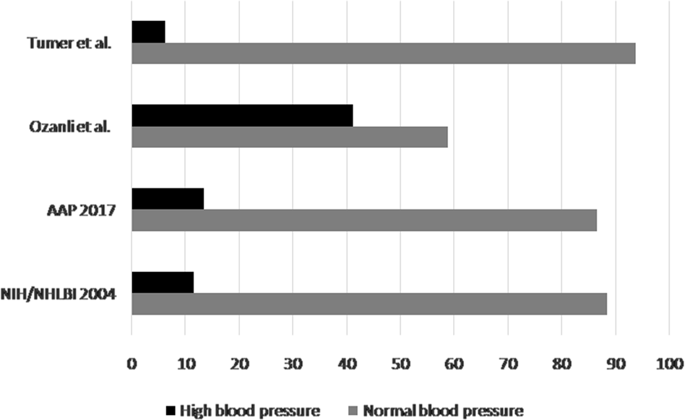Journal of Human Hypertension ( IF 2.7 ) Pub Date : 2019-11-26 , DOI: 10.1038/s41371-019-0290-z Mehmet Agirbasli 1 , Hatice Feyza Dilek 2 , Mustafa Adem Tatlisu 1 , Handan Ankarali 3

|
Epidemiological studies indicate that elevated blood pressure (BP) is common among children. Early detection of elevated BP in children is important in the prevention of cardiovascular disease (CVD). Difficulties exist in the diagnosis of “elevated” BP in children of 8–12 years of age. Normative tables of sex, age, and height specific BP percentile levels are required. Reports provide normative tables of BP percentile levels in children. Elevated BP is defined as systolic and diastolic BP ≥ 90th age, sex, and height specific BP percentile. The study tests the internal consistency and reliability between the normative tables of BP in children. The main objective of the study is to assess the reliability of existing normative tables of BP in children by using ad hoc analysis of a prior survey. A cross-sectional survey was performed in elementary school children (8–12 years of age, n = 818) from Istanbul, Turkey. The survey was conducted in 2007–2008. Four different normative tables of BP were used to determine children with elevated BP. The reliability and internal consistency between the normative tables of BP in children were assessed. The prevalences of elevated systolic and diastolic BP in children differed significantly between the normative tables of BP. The internal consistency between the normative tables was poor (Cronbach α coefficient = 0.429). Kuder–Richardson 21 test indicated poor reliability between the local and international normative tables of BP. In conclusion, the study indicates that there are significant inconsistencies and poor reliability between the national and international normative tables of BP in children.
中文翻译:

评估儿童血压升高的规范表的可靠性。
流行病学研究表明,血压升高 (BP) 在儿童中很常见。早期发现儿童血压升高对于预防心血管疾病 (CVD) 很重要。8-12 岁儿童血压“升高”的诊断存在困难。需要性别、年龄和身高特定血压百分位水平的规范表。报告提供了儿童血压百分位水平的规范表。血压升高定义为收缩压和舒张压 ≥ 90 岁、性别和身高特定的 BP 百分位数。该研究测试了儿童血压规范表之间的内部一致性和可靠性。该研究的主要目的是通过使用先前调查的临时分析来评估现有儿童血压规范表的可靠性。n = 818) 来自土耳其伊斯坦布尔。该调查于 2007-2008 年进行。四种不同的血压标准表用于确定血压升高的儿童。评估了儿童血压规范表之间的可靠性和内部一致性。儿童收缩压和舒张压升高的患病率在血压规范表之间存在显着差异。规范表之间的内部一致性较差(Cronbach α系数 = 0.429)。Kuder-Richardson 21 检验表明当地和国际 BP 规范表之间的可靠性较差。总之,该研究表明,国家和国际儿童血压规范表之间存在显着的不一致和较差的可靠性。



























 京公网安备 11010802027423号
京公网安备 11010802027423号